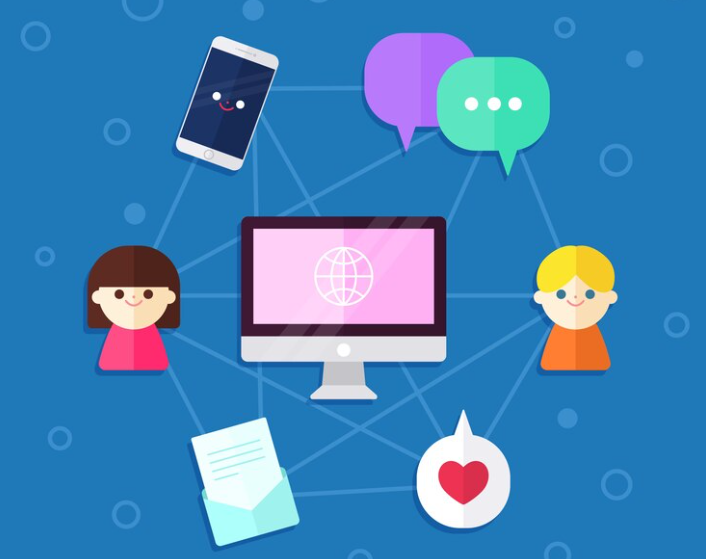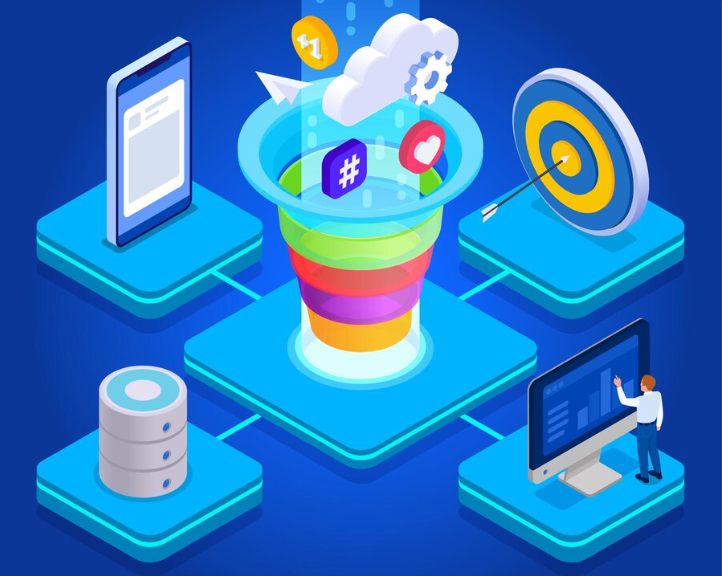Omnichannel marketing: secrets of effective communication with customers
-
Vladimir Kosygin
Copywriter Elbuz
Waking up in a cold sweat, I realized that the world of marketing was about to turn into a real tangle of mysteries and experiences. How did it happen? How did I end up here, where each step was an independent thread in the omnichannel marketing system? Prepare yourself for an exciting journey into the world of effective customer communication, where secrets and discoveries await you around every corner. But be careful—learning these secrets is just the beginning!

The essence of omnichannel marketing
Omnichannel marketing is a strategy that allows businesses to establish effective communication with customers through various channels. This strategy connects all of the company's channels to provide customers with a single, consistent experience and support anywhere, anytime. These channels may include an online store website, an offline store, a mobile application, contextual and targeted advertising, email and SMS newsletters, social networks and instant messengers.
The essence of omnichannel marketing is that all channels work in harmony and offer customers the same information, prices, promotions, communication style and level of service. Regardless of which channel the client interacts with the company, he will always receive uniform and accurate information, as well as support at any stage of the purchase or application.
The main goal of omnichannel marketing is to create a smooth and convenient interaction with customers and provide them with the most comfortable use of the company’s products and services. With an omnichannel strategy, customers can easily switch between different channels while maintaining continuity, security and quality of service.
Benefits of omnichannel marketing
The use of omnichannel marketing in business can bring a number of significant benefits:
- Wider reach of customer audience : Through the use of various channels, the company can reach a larger audience of customers and attract new potential buyers.
- Improving the quality of service: Omnichannel marketing allows a company to provide high-quality customer support at various stages of purchase or treatment.
- Increasing customer loyalty : Providing a consistent style of communication and high levels of service creates a positive customer experience that promotes brand loyalty.
- Increased sales : Holistic and consistent communication with customers can significantly increase sales and increase company revenue.
- Performance Analysis: Omnichannel marketing allows a company to conduct a detailed analysis of the effectiveness of each channel and optimize their performance to achieve better results.

Principles of omnichannel marketing
Work on the implementation of omnichannel marketing allows a business to create a single space for communication with customers. To do this, there are several important principles to consider:
- Channel Integration : All channels must be integrated to provide a single, consistent customer experience.
- Consistent style : All omnichannel marketing communications should be consistent and have the same design, communication style and tone of voice.
- Personalization : Each customer should receive a personalized experience with the company based on their preferences and needs.
- Customer tracking : Omnichannel marketing requires constant engagement with customer data and analysis of their preferences and behavior to effectively personalize and deliver relevant offers.
Practical tips for improving customer communication
- Use analytics : Constantly analyze your customer data to identify their preferences and needs. This will help you provide relevant offers and personalized experiences.
- Integrate channels : Ensure that all channels you use are integrated so customers can seamlessly switch between them and maintain a seamless experience.
- Provide consistent information : Ensure that all channels provide customers with the same information about products, services, promotions and prices.
- Simplify the path to purchase : Make the purchasing process as simple and convenient as possible so that customers can purchase products quickly and easily.
- Provide a high level of service: Provide high-quality and timely support to customers at all stages of interaction with the company.
- Feedback : Actively collect feedback from customers and use it to improve your products and services.
👉 Omnichannel marketing best practices:
- Integrate all channels into a single system for complete omnichannel communication.
- Keep information up-to-date across all channels and actively improve your processes.
- Offer personalized experiences to your customers and adapt to their needs.
- Analyze data and conduct testing to determine the most effective communication channels.
- Keep up with trends and new technologies in omnichannel marketing to stay ahead of the competition.

Conclusion
Omnichannel marketing is not just a mechanism for communicating with customers, it is a strategy that helps a business achieve maximum efficiency and satisfy needs of modern buyers. A variety of communication channels helps the company reach a wide audience and maintain constant contact with customers.
To successfully implement omnichannel marketing, it is necessary to adhere to a number of principles, such as channel integration, uniform style and personalization. Practical tips will help you improve communication with clients and achieve greater business success.
📊 Review:
Do's Don'ts Integrate all channels Keep channels isolated Provide high level of service Ignore customer needs Provide personalized experiences Offer one-time promotions Analyze customer data Ignore feedback Simplify the purchasing journey Complicate the purchasing process Following these principles and using an omnichannel approach will help your business achieve greater success and improve communication with clients.
We hope this information helps you better understand omnichannel marketing and implement this strategy into your business for maximum results.
Difference from multichannel marketing
Omnichannel marketing: a single message for the customer
Some may confuse omnichannel and multichannel marketing because they have a lot in common. Multichannel marketing is the simultaneous promotion of goods and services through different channels. But in this case, unlike omnichannel marketing, the actions of all promotion channels are separate. As part of multichannel marketing, each channel can have its own promotion strategy and not be coordinated with each other. For example, a client saw a letter with a promotional offer and called the store to consult on a promotional product, and a few days later received a newsletter about the same promotion, but in Viber. This way, the same customer who moves between channels will be perceived as new every time. This can lead to misunderstandings in working with clients and a decrease in the level of service.

*️⃣ Omnichannel marketing is the next step in the development of multichannel marketing. No customer communication channel works independently of the others. The store not only provides customers with different communication channels, but also integrates them to provide a unified and consistent customer experience.
Principles of Omnichannel Marketing
The core idea of omnichannel marketing is to create a seamless and consistent customer experience. This is achieved by integrating all communication channels into a single system that allows customers to move between them, while maintaining all the data and context of the interaction.
🔹 Customer Data: Omnichannel marketing is built on knowing and understanding the customer. All information about the client is stored in a single database, accessible to all communication channels. This allows you to create a more personalized and targeted approach to each client.
🔹 Single message: All communication channels use the same message and style of communication with the client. This allows you to create a cohesive and recognizable brand that customers can easily identify with, regardless of which channel they use to communicate with the company.
🔹 Contextual interaction: When a customer switches from one channel to another, its context and interaction history are preserved. For example, if a customer started placing an order on the website, but decided to ask a question by phone, the contact center employee will already know about his recent interaction with the site. This allows communication to continue where it left off and improve service levels.
🔹 Consistent experience: All communication channels with customers are consistent with each other. This means that the client, using any channel, will receive the same level of service and capabilities. For example, if a customer receives a promotional offer on the website, he can also take advantage of this promotion in the store or through a mobile application.
Practical tips for effective omnichannel marketing
🔹 Channel integration: It is important to integrate all communication channels so that they work together and exchange customer data.
🔹 Unified Database: Create a centralized customer database where you can store customer information from all channels.
🔹 Personalized Communication: Use customer data to create personalized communications and offers.
🔹 Consistent style and message: Ensure that all communication channels use the same style of communicating with customers and convey a single message.
🔹 Provide convenient channels: Focus on the channels that are most convenient for your target audience and offer customers choice.
🔹 Regular data updates: Keep your customer data up-to-date and accurate so you don't send them unnecessary information.
🔹 Measuring results: Measure the results of omnichannel marketing and make adjustments to your strategy based on the data obtained.

Expert opinion
"Omnichannel marketing gives companies the opportunity to build deep and productive relationships with customers. Integration of communication channels allows "Build a strong brand and provide customers with convenience and a high level of service. Given the growing number of channels of interaction with customers, the difference from omnichannel marketing is becoming increasingly significant. Investing resources in an omnichannel strategy will allow the company to reach a new level in communicating with customers." - Dmitry Minenko, marketing expert at Auchan.
Conclusions:
Omnichannel marketing differs from the multichannel approach in that it offers the integration of all channels of communication with customers into a single system. This allows you to create more effective and consistent communication with customers, as well as attract their attention and loyalty to the brand. Using omnichannel marketing allows companies to satisfy the needs of modern consumers and compete effectively in the market.
Overview table
| What to do | What not to do |
|---|---|
| Integrate communication channels | Leave communication channels separate |
| Create a single database | Ignore customer information |
| Personalize communications | Use the same approach for everyone |
| Update customer data | Launch marketing campaigns at random |
| Measure results | Don't listen to customer feedback |

Effective use of omnichannel marketing will help your business improve communication with customers, attracting new ones and retaining existing ones. Only by creating a unified and coordinated system of interaction with clients can you be sure that each client receives a single and unique customer experience from your company.
Benefits of Marketing
One of the key elements of a successful business is effective communication with customers. The success of your company depends on how well you can interact with customers. Omnichannel marketing opens up new opportunities for you to create strong, long-lasting relationships with your audience.
Improving the customer experience
Omnichannel marketing offers a unique approach to customer service. Customers interact with your store on the same level across multiple channels and receive up-to-date information. Thanks to this approach, customers do not get lost and the store always knows at what stage of interaction they are.
Saving resources
In traditional marketing, a store has to spend time, effort and money to attract new customers. However, in omnichannel marketing, you already have customers that you are already working with. Therefore, saving time and resources on promotion among an existing audience becomes much easier and more effective.
Operational integrity
Omnichannel marketing allows a store to easily analyze its performance, since all channels of interaction with customers are synchronized. This helps the store better understand which channels are most effective and what changes can be made to improve the customer experience.
Improved targeting
One of the main advantages of omnichannel marketing is that all the customer information collected by different channels is consolidated in one place. This allows you to personalize advertising and offer customers only what they might actually be interested in. Thanks to this approach, promotion efficiency increases significantly.

Increasing promotion efficiency
In omnichannel marketing, all channels support each other and work towards one common goal, as part of a common promotion strategy. This ensures that all advertising messages are consistent and create a consistent image of your brand in the eyes of customers.
Using CRM to improve marketing efficiency
Omnichannel marketing is inseparable from the use of CRM (Customer Relationship Management), which means customer relationship management. CRM systems help automate and optimize customer interactions, as well as analyze and use data to make informed marketing decisions.

Omnichannel marketing allows you to build deep and productive relationships with your customers, ensuring they have a positive experience with your brand. To achieve success in modern business, it is important to employ effective marketing strategies, including an omnichannel approach.
“Correct communication with customers is one of the key factors for successful marketing. An omnichannel approach helps businesses effectively interact with audiences and create long-term relationships” - Evan Gill, marketing expert at Reebok.
Overview of the benefits of omnichannel marketing
| What's good to do | What not to do |
|---|---|
| Segment audiences and personalize communications | Don’t leave customers unattended |
| Optimize channels of interaction with clients | Don’t ignore customer feedback |
| Use CRM systems to manage client data | Don’t limit yourself to just one communication channel |
Omnichannel marketing is a strategy that helps you effectively reach diverse audiences and create lasting relationships with your customers. With omnichannel marketing, you can improve customer service, save resources, improve targeting, and increase the effectiveness of promoting your brand.
Find out why CRM is important and start using omnichannel marketing today to improve communication with your customers and achieve success in your business!
How omnichannel marketing works
Omnichannel marketing is a strategy that integrates all available communication channels to effectively interact with customers. This allows the organization to gain a deeper understanding of its customers and provide them with a more personalized experience.
Implementing Omni-Channel Marketing
Omni-channel marketing enables seamless customer interactions across various communication channels such as websites, mobile apps, social media, email and traditional offline channels. An organization that practices omnichannel marketing offers its customers a consistent experience regardless of the channel they choose for their interactions.
Benefits of Omnichannel Marketing
Improved Customer Communication
Omnichannel marketing allows you to connect with your customers on a deeper level by offering them a personalized experience. This makes customers feel unique and important to the organization, which increases customer loyalty and retention.
Greater flexibility and convenience for consumers
Omnichannel marketing allows customers to interact with an organization through multiple channels and choose the method that is most convenient for them. For example, a customer can start the purchase process in an online store and finish it in an offline store, while all information and preferences are saved.

Increase conversions and sales
Omnichannel marketing helps an organization reach potential customers more effectively and engage them in the buying process. Through personalization and deeper understanding of customers, organizations can offer more relevant offers and recommendations, increasing the likelihood of a purchase.
Principles of omnichannel marketing
Unified customer profile
One of the basic principles of omnichannel marketing is the creation of a single customer profile, which contains all the necessary information about his preferences, purchases and interactions with organization. Thanks to this, the organization can provide a personalized experience at all stages of the customer journey.
Uniformity of information
It is important that information is transmitted uniformly and continuously between different communication channels. For example, a customer who adds an item to their cart on a mobile app should be able to see that item in their cart on the website or receive information about promotions and discounts via email. This creates a seamless experience for customers and a seamless experience with the organization.
Data Analysis and Performance Measurement
Omnichannel marketing organizations actively analyze customer data and measure the effectiveness of their marketing campaigns. This allows them to understand which channels and strategies are most effective and how they can optimize their communications with customers.
Omnichannel marketing best practices
Create a single customer profile and implement a customer data management system to effectively collect and analyze customer information.
Use automated tools to coordinate and synchronize communications between different channels.
Offer personalized offers and recommendations based on customer preferences and behavior.
Actively track and measure the results of your marketing campaigns to optimize customer communications and improve their experience.
Ensure smooth operation of all communication channels and quick response to customer requests.
Review of omnichannel marketing best practices
| Helpful | Not helpful |
|---|---|
| Creating a single customer profile Personalizing communication Effective data analysis | Disjointed storage of customer information Disorganized interaction between channels Lack of performance measurement system |
In conclusion, omnichannel marketing is becoming increasingly relevant in modern business. By allowing customers to interact with the organization through various channels, this strategy improves customer communication, increases loyalty, increases conversion and sales. By following omnichannel marketing best practices, you can improve your marketing strategy and provide more effective interactions with your customers.

🔗 You may also be interested in the marketing strategy guide, which will help you develop an effective plan to achieve your business goals.
What you need to implement omnichannel marketing
Identify your target audience
One of the important steps in implementing omnichannel marketing is identifying your target audience. To provide your customers with the best user experience, you need to know who they are and what they want. This will help form a portrait of the client, taking into account his interests, age, marital status and other demographic characteristics. Knowing who you are talking to will make it easier to understand their behavior and reactions.
Select the most relevant promotion channels
Omnichannel marketing involves giving customers multiple options to interact with your store. However, to keep your work simple, you can remove individual channels if they are not delivering results. To do this, you need to find out which channels your customers like, that is, which ones are effective in terms of communication and sales. This could be mail, phone calls, instant messengers, social networks and others. Focus on the most effective channels to attract and retain your customers.
Create a sales funnel
Explore the journey customers take to make a purchase in your store. Break this path into several stages and record it in the form of a sales funnel. Start by introducing customers to the store or product and guide them through each step until the actual purchase. A sales funnel will help you better understand at what point customers are likely to fall through the cracks and allow you to implement appropriate strategies to retain them during the buying process.
Use CRM to manage customer communications
Omnichannel marketing requires good organization and management of customer communications. One way to do this is by using a CRM (Customer Relationship Management) system. CRM allows you to collect and store information about customers, their preferences and history of interaction with your company. This will help you improve personalization of communications and provide better service.
Data-Driven Strategy
To successfully implement omnichannel marketing, you need to develop a data-driven strategy. Analyze information about customers, their preferences, behavior and other factors to understand how to best communicate with your audience. Use this data to develop personalized campaigns, emails and offers that will be most attractive to your customers.

Summary
Implementing omnichannel marketing requires certain steps and strategies. Defining your target audience, selecting the most relevant promotion channels, using a sales funnel and data-driven strategy are all important components of successful customer communication. Remember to use CRM systems to manage communications and be data-driven to keep your marketing efforts at the highest level.
Conclusion
Omnichannel marketing is the pinnacle of business management and customer service. Companies that put it into practice provide their customers with a better user experience. If your business is already so developed that you have an offline and online store, then think about introducing omnichannel marketing. It's not easy, but it's worth it.
What did we find out in this article about omnichannel marketing? First, we learned that omnichannel marketing is a comprehensive customer communications strategy that integrates various sales and communications channels into one cohesive system. It helps a business provide a single, consistent experience to the customer no matter which channel they use to interact with the company.
Secondly, we understood the basic principles of omnichannel marketing. It requires the integration of all sales and communication channels, as well as the use of data and analytics to more effectively interact with customers. We discussed the importance of personalization and active customer participation in the communication process.
We also shared the secrets of effective communication with clients based on the principles of omnichannel marketing. We covered a number of practical tips, such as using consistent branding, personalizing messages, and managing reviews and customer feedback. We also emphasized the importance of data analytics to better understand the needs and preferences of your customers.
Finally, we analyzed the benefits of omnichannel marketing and its impact on business. It helps improve customer loyalty, increase sales and increase company profits. Effective communication with customers across all channels is a key success factor in modern marketing.

Conclusions and next steps:
- Omnichannel marketing is an effective strategy for improving customer communication and increasing company profits.
- Companies that use omnichannel marketing provide their customers with convenience and a personalized shopping experience.
- To successfully implement omnichannel marketing, it is necessary to use sales channel integration, data analysis and active communication with customers.
- The benefits of omnichannel marketing include improved customer loyalty and increased sales.
Implementing omnichannel marketing can be a challenge, but the benefits it provides make it worth the effort. Be prepared to adapt and embrace the opportunities that omnichannel marketing can offer your company. Improving communication with clients and creating deeper relationships are key factors for success.
"Omnichannel marketing gives companies the ability to effectively engage with customers and meet their needs, regardless of the communication channel they choose." - Samantha Claire, Dell Marketing Expert.
Useful actions to take:
| Things to do | What to avoid |
|---|---|
| Integrate different communication channels | Ignore customer feedback |
| Analyze data and use analytics to identify customer needs | Avoid personalization |
| Improve customer service and communication | Avoid omnichannel marketing into business strategy |
| Actively interact with customers, answer their questions and feedback | Use conflict situations to increase customer loyalty |
As practice shows, effective communication with customers through various sales and communication channels helps to increase sales and customer loyalty. Omnichannel marketing is one of the tools that allows you to achieve this goal. Consider implementing omnichannel marketing into your business and start improving your customer communications today.

Tommy Hilfiger Experience

Tommy Hilfiger is an international clothing brand known for its stylish and fashionable designs. The company was founded in 1985 by Tommy Hilfiger and quickly became a recognized leader in the fashion industry. It offers a wide range of products including men's, women's and children's clothing, footwear, accessories and fragrances.
Client Description, Their Business and Goals
Tommy Hilfiger is a global brand whose goal is to offer fashionable, quality and affordable products to its customers. They strive to become one of the leading companies in the fashion industry, offering their customers a wide range of stylish clothing and accessories.
The main goals of the Tommy Hilfiger company:
- To establish strong relationships with existing customers and attract new customers.
- Expand your audience and increase brand awareness.
- Increase sales volume and overall profit of the company.
- Satisfying customer needs by offering high quality products and services.
The main problem to be solved
The main problem of the Tommy Hilfiger company was to create an effective marketing strategy that would help achieve their goals and satisfy the needs of their customers. They wanted to develop an approach that could reach a wider audience, strengthen connections with existing customers and increase sales.
Description of the characteristics and interests of the target audience
The target audience of the Tommy Hilfiger company includes men and women aged 25 to 45 years who value style, quality and fashionable clothing. They strive to look attractive and follow the latest fashion trends. The target audience is also interested in products with good value for money, as well as attractive promotions and discounts.
Key points that may be of interest to potential customers:
- Wide selection of fashionable and stylish products for men and women.
- High-quality and durable materials.
- Fashionable and current collections reflecting the latest fashion trends.
- Affordable prices and attractive promotions that allow you to save on your purchases.
Facts, figures and results of the project
With the help of omnichannel marketing, Tommy Hilfiger was able to achieve significant results:
- Increased brand awareness in the fashion market. By using all available communication channels, the company was able to achieve maximum audience coverage and attract new customers.
- Increase in sales volume and overall profit. Thanks to a carefully developed marketing strategy, Tommy Hilfiger was able to increase its sales and profits by attracting more customers and increasing the loyalty of existing customers.
- Improved customer interaction. Through an omnichannel marketing strategy, the company was able to establish strong connections with customers and improve customer satisfaction.
Thanks to the successful implementation of omnichannel marketing, Tommy Hilfiger was able to achieve its goals, improve its position in the fashion market and satisfy the needs of its customers. This experience highlights the importance of omnichannel marketing to effectively communicate with customers and achieve business goals.
"Omnichannel marketing is not just a strategy, but an opportunity to deeply connect with customers and unlock the potential of your business." - Sabrina Carter, Tommy Hilfiger
Video: Inside Tommy Hilfiger’s American Dream | The Business of Fashion
“Omnichannel marketing is not just a strategy, but an opportunity to deeply connect with customers and unlock the potential of your business.” - Tommy Hilfiger.
Frequently asked questions on the topic “Omnichannel marketing: secrets of effective communication with customers”
What is omnichannel marketing?
Omnichannel marketing is a strategy that integrates all of a company's communication channels to create a single, consistent customer experience.
What is the difference between omnichannel marketing and multichannel marketing?
Unlike multichannel marketing, omnichannel marketing offers customers a consistent experience regardless of the channel they choose to engage with a brand.
What benefits does omnichannel marketing offer?
Omnichannel marketing can improve brand awareness, increase customer satisfaction, increase the likelihood of repeat purchases and improve overall business results.
How does omnichannel marketing work?
Omnichannel marketing works by synchronizing and integrating communication channels such as website, social media, email, mobile apps and others to provide customers with a unified and seamless experience.

What is needed to implement omnichannel marketing?
To successfully implement omnichannel marketing, it is necessary to analyze customer behavior, create a unified customer database, integrate all communication channels and establish mechanisms for coordinating customer experience.
What are the secrets of effective communication with customers within the framework of omnichannel marketing?
The secrets to effective omnichannel marketing communications with customers include personalizing messages, being active in customer channels of choice, and delivering a consistent experience across multiple touchpoints.
What are the basic principles of omnichannel marketing?
The core principles of omnichannel marketing include integrating channels, aligning messaging and interactions, incorporating customer context, and delivering a consistent, seamless experience across the customer journey.
Can you give some examples of companies using omnichannel marketing successfully?
Some examples of companies using omnichannel marketing successfully include Amazon, Starbucks, Nike, and Apple. These companies offer customers a consistent and seamless experience across multiple channels.
What tools can be used to implement omnichannel marketing?
To implement omnichannel marketing, you can use tools such as CRM systems, marketing automation, data analytics, social networks, mobile applications and others.
How can I evaluate the effectiveness of omnichannel marketing in my business?
Measuring the effectiveness of omnichannel marketing includes analyzing key performance indicators (KPIs), monitoring customer response, conducting surveys and customer feedback, and analyzing sales and repeat purchase data.
🎉 Thank you for learning the secrets of effective communication! 🎉
You are now officially an omnichannel marketing pro! You've gained knowledge that will help you interact with customers on a new level.
Now you know that omnichannel marketing is not just about being present on different channels, but also about deeply understanding the needs and preferences of your audience. You've learned the principles that help you create a consistent, seamless experience for your customers, no matter what channels they use to interact with your brand.
We also shared with you the secrets of effective communication with clients through various channels. You learned how to create engaging content, use personalization and contextual advertising, and actively interact with customers through social networks and instant messengers.
Now your business is ready for new challenges and successful interaction with customers at all levels. Good luck in mastering omnichannel marketing and reaching new heights!
💪 Don’t forget to put your knowledge into practice and have fun!
👍 We wish you many creative and successful projects!

Video: What is the difference between omnichannel and multichannel?
- The essence of omnichannel marketing
- Difference from multichannel marketing
- Benefits of Marketing
- How omnichannel marketing works
- What you need to implement omnichannel marketing
- Conclusion
- Tommy Hilfiger Experience
- Video: Inside Tommy Hilfiger’s American Dream | The Business of Fashion
- Frequently asked questions on the topic “Omnichannel marketing: secrets of effective communication with customers”
- Thank you for learning the secrets of effective communication!
- Video: What is the difference between omnichannel and multichannel?
Article Target
Talk about the concept of omnichannel marketing, explain its advantages and principles of operation, and provide practical advice on improving communication with customers.
Target audience
Business owners, marketers, sales professionals interested in effective marketing strategies and improving customer communication.
Hashtags
Save a link to this article
Vladimir Kosygin
Copywriter ElbuzWords are tools, and my mission is to breathe life into online store automation. Welcome to the world of my texts, where every line fills business with meaning and efficiency.
Discussion of the topic – Omnichannel marketing: secrets of effective communication with customers
Find out what omnichannel marketing is, how it works, and why it's important for your business. Let's understand the basic principles and share the secrets of effective communication with clients.
Latest comments
13 comments
Write a comment
Your email address will not be published. Required fields are checked *





























Irina
Very interesting article! I have long noticed that our company’s clients increasingly expect communication through different channels. What omnichannel marketing principles will help us effectively interact with our audience?
Nikita
I agree, Irina! Nowadays people want to receive information everywhere and always. This is especially true in our industry. Sharing communication experiences will be useful. We had a case when one of the clients contacted Facebook support, and we didn’t even have an account there! What secrets can you share about effective communication with clients?
Natasha
Hi all! Last year we had an interesting experiment with omnichannel marketing. We launched a newsletter, then repeated the content on the blog and social networks, and held a webinar on this topic. The results were amazing! Customer interest has increased several times. Do you have experience with omnichannel marketing?
Grumpy
Omnichannel marketing and other trends... Do you think they are really necessary? I have always believed that a good quality product and excellent service are more important than various marketing gimmicks.
Elena
Hello Grumpy! I understand that many trends look like marketing tools. But omnichannel communication with customers can really improve interactions. It allows you to be closer to your customers and better understand their needs. What marketing tools do you consider necessary in our time?
Sergei
Hello Elena! I agree with you. In addition to omnichannel, these are analytics and personalization. Data analysis allows you to understand which channels are most effective and which audiences you should focus on. And personalization helps create more targeted and relevant messages. What analytics tools do you use in your company?
Dima
Hello, Sergei! In our company, we use Google Analytics to analyze data. This helps us track traffic, visitor behavior and conversions. We also use tools such as Hotjar and Crazy Egg to analyze user experience on the site. They allow you to see how users interact with pages. Do you have experience with Google Analytics or other analytics tools?
Viktoria
Hello Dima! We also use Google Analytics and have recently started experimenting with Google Tag Manager. This is really handy when you need to add event or conversion tracking to your site without the need for developer intervention. Besides Google tools, did you use anything else to analyze data?
Grumpy
You all keep discussing these marketing tools. Why reinvent the wheel? We have always had a traditional need. People receive information from information brokers - neighbors, friends, colleagues. And the Global Web is even better. For all this marketing from gray dry cleaners, you will never get your costs back. Clients are not suckers.
Nikita
Grumpy, I understand that this is foreign to you, but the world is changing, and clients are changing with it. Today's generations are increasingly mastering online communication channels. We must adapt. How do people find out about your company?
Irina
Nikita is right! Today it is so important to be visible on the Internet, to establish a dialogue with clients through social networks and instant messengers. Recently, our company started using WhatsApp to communicate with clients, and this has given a noticeable increase in conversions. Tell me, does anyone else have experience with instant messengers in marketing?
Sergei
Irina, we also launched WhatsApp support. Being able to solve customer problems in real time is truly valuable. Besides WhatsApp, has anyone tried using any other instant messengers for business communications?
Natasha
Oh, this is mine! I do Telegram support in our company. More and more clients prefer to use their favorite messenger to quickly communicate with us. Besides WhatsApp and Telegram, what messengers do you use?